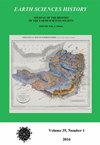伊朗矿物学和宝石学史
IF 0.6
4区 哲学
Q4 GEOSCIENCES, MULTIDISCIPLINARY
引用次数: 0
摘要
伊朗是世界上最早的一些文明的发源地。阿什卡尼亚王朝(公元前550-330年)将伊朗统一为一个超级帝国。它是迄今为止最大的帝国,也是居鲁士大帝统治的从巴尔干半岛到北非和中亚的第一个世界帝国。随后,伊朗在其历史进程中被马其顿人、阿拉伯人、土耳其人和蒙古人入侵。在这些时期,伊朗失去了大部分领土,直到公元19世纪形成了一个缩小的伊朗。尽管受到入侵,伊朗并没有失去其先前文明的遗产,而是将新文明的各个方面纳入其文化结构。伊朗一直在自然科学、医学、数学、天文学、哲学以及矿物学和宝石学方面发挥有效作用。有时,伊朗处于科学和技术的前沿,包括矿物学和宝石学,这些都经历了发展阶段。第一阶段和第二阶段分别发生在伊斯兰教传入之前和之后。在古代和伊斯兰伊朗时期,有30多本关于矿物和宝石的书。这些书可以分为三大类,第一类包括宝石、矿物、宝石和金属。第二组书籍集中在自然史、化学和宝石方面。第三组书籍讨论了医学、药物化学和矿物的医学性质。最著名的文献是由早期的伊朗科学家如阿维森纳、比uni、Jabir Ibn Hayan、Kandi和Razi所写。伊朗在科学和技术(包括矿物学和宝石学)的前沿地位在萨法维王朝(公元1501-1736年)崩溃后有所下降。但是最近,在过去的50年里,伊朗通过教育、培训和研究在科学技术方面取得了相当大的进步。这将为伊朗在21世纪的科学和技术以及矿物学和宝石学方面开启一个新的发展时代本文章由计算机程序翻译,如有差异,请以英文原文为准。
THE HISTORY OF MINERALOGY AND GEMOLOGY IN IRAN
Iran is home to some of the world’s earliest civilizations. The Ashkanian dynasty (550–330 BCE) unified Iran as a superpower empire. It was the largest empire yet seen and the first world empire where the Great Cyrus ruled from the Balkans to North Africa and Central Asia. Subsequently, Iran was invaded by the Macedonians, Arabs, Turks and the Mongolians over the course of its history. During those times, Iran lost much of its territory until a reduced Iran was formed in the nineteenth century CE. Despite the invasions, Iran did not lose its heritage from its previous civilizations, but rather incorporated aspects of the new civilizations into its cultural fabric. Iran has always played an effective role in the natural sciences, medicine, mathematics, astronomy, philosophy and also in mineralogy and gemology. At times, Iran was at the forefront of science and technology, including mineralogy and gemology, which went through stages of development. The first and second stages occurred before and after the introduction of Islam, respectively. More than 30 books were written about minerals and gems during the ancient and Islamic Iranian periods. Those books can be classified into three main groups where the first group included accounts of precious stones, minerals, gems and metals. The second group of books focused on natural history, chemistry and precious stones. The third group of books discussed medicine, pharma-chemistry and medical properties of minerals. The most famous texts were written by early Iranian scientists such as Avicenna, Biruni, Jabir Ibn Hayan, Kandi and Razi. Iran’s role at the forefront of science and technology (including mineralogy and gemology) declined after the collapse of the Safavid dynasty (1501–1736 CE). But recently, during the past 50 years, Iran has made considerable advances in science and technology through education, training and research. This will open a new age of development for Iran in the twenty-first century in science and technology as well as in mineralogy and gemology
求助全文
通过发布文献求助,成功后即可免费获取论文全文。
去求助
来源期刊

Earth Sciences History
GEOSCIENCES, MULTIDISCIPLINARY-HISTORY & PHILOSOPHY OF SCIENCE
CiteScore
1.00
自引率
0.00%
发文量
1
审稿时长
>12 weeks
期刊介绍:
Earth Sciences History promotes and publishes historical work on all areas of the earth sciences – including geology, geography, geophysics, oceanography, paleontology, meteorology, and climatology.
The journal honors and encourages a variety of approaches to historical study: biography, history of ideas, social history, and histories of institutions, organizations, and techniques.
Articles are peer reviewed.
 求助内容:
求助内容: 应助结果提醒方式:
应助结果提醒方式:


